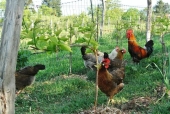posted 11 years ago
Such a meter would be difficult to quantify, but coming up with some rough figure would be at least a good starting point for someone to repeat this project.
I'm going to throw out a wild estimate: 5 cubic yards per hen. At 1000 pounds per cubic yard (cuyd), 5 cuyds=5000 pounds of decomposing material per chicken.
My girls were doing just fine on 10 cuyds of leaf mold, about 8 cuyds of spent mushroom compost, a few small heaps of grass clippings and leaves totalling around 4 cuyds, a hot compost heap of 3 cuyds, plus a half acre of natural forest floor litter, half an acre of sometimes mowed grass, a few hundred pounds of hay the bull was finished working over, plus all his manure for the previous few months. They did not scour the place. Plenty of the woods were pecked here and there. Lots of manure just sat there. Heaps that were flattened stayed flat for weeks and months before being rebuilt. They hit the leaf mold regularly, as well as the hot compost heap. When they find a good spot somewhere, they give it a good working over.
A dozen hens can easily spread out a single cubic yard in a day of work if they set their minds to it, stay focused, cheer each other on. The equation would depend on the bug population, time of year, carrying capacity of the pile, size of the pile, the human effort and attention being put in, rates of use and replenishment of the heap(s), moisture levels, ingredients, heap activity...
A thriving bug population with a full demographic pyramid in a suitable heap could sustain it's population as long as the hens don't overeat and other factors such as frost don't change the environment. A heap with ingredients which the chickens can eat would give the bugs an increased survival rate. An active, moist heap would be expected to support more life than an aged, dry heap. Cold weather will slow things down-more volume would be needed as the population in the heap declines.
The leaf mold heap was large enough that a bird in the middle could not fling material all the way to the ground. The result was pits and bowls here and there. The girls used them for naps and hangouts. The hot compost heap was not scratched into as deeply, probably from the heat, and was rebuilt much more frequently. The added attention kept it lively. In the grass heap, I've seen them eating the grass and weed clippings. After the leaf mold and hot compost, their favorite stomping ground was out back in the woods. If they were in the field poking around hay r compost, it was in the morning or evening; Perish the thought of getting a sunburn.
5 cuyds of material/chicken is not written in stone. Far from it. Your compost heap is different from mine, as is your environment, and the breed of hens. Your situation may require more or less material. What we need is more data to consider.
If anyone else uses compost to supplement the feed of chickens, it would be handy to hear from you.
Seed the Mind, Harvest Ideas.
http://farmwhisperer.com

 1
1




 2
2




 2
2












 4
4









 2
2









 1
1








 1
1




















